
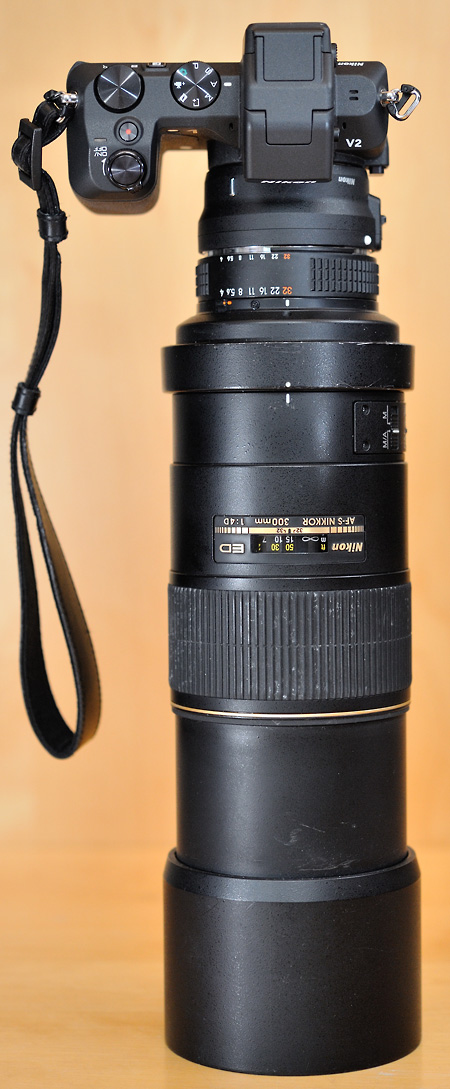
|
|
810mm equivalent: Nikon 1 V2 plus FT-1 adapter plus AF-S Nikkor 300mm f/4.
|
In terms of optical performance the AF-S 300mm f/4 is probably the best lens I currently own. I use it in conjunction with my FX cameras (D700 and D4) and often combined with my TC-14EII. It is an old lens, released in 1999. Me and many other people are waiting for a successor with VR...
Sometimes I wish to have more reach. Well, I could sell my car and buy an AF-S 800mm f/5.6 instead ;) Even if I had the money that is not what I am looking for. I would like to have a relatively lightweight option.
My first try were the old TC-301 and TC-201 MF teleconverters between the D700 and the 300mm lens. The results were acceptable, but manual focussing without reliable help from the AF-System is a serious practical issue. Have a look at my article about teleconverters and my subjective lens evaluations. Today, with the D4, a TC-20EIII would be an option with autofocus. Maybe, I will try it...
An alternative for getting more reach is to use a digital zoom. For example, using a D300 instead of a D3 or a D800 instead of a D4 is a digital 1.5x-zoom at the same pixel count. But the Nikon 1 sensors are much smaller than a DX sensor: they have a size of only 13.2x8.8mm. Nikon calls this CX format. The crop factor from FX to CX is 2.7, thus the FX-equivalent of my 300mm lens on a CX sensor is 810mm. That is definitively more reach! The Nikon 1 V2 camera discussed here has 14MP which is comparable to the D4's 16MP. On the other hand, an FX sensor with the pixel density of the V2 would have 14MPx2.72 = 102MP!
So far the theory. But what about the combination of my 15-year-old lens and the high pixel density of the CX sensor in practice? To cut a long story short: In terms of the potential image quality it is a great combination! The resolution of the lens seems to be really high and the image quality of the small sensor is surprisingly good. Before I discuss the practical issues of this combination I will start with a short review of the Nikon 1 system itself.
For trying the System 1 I needed a camera with a viewfinder. Without, it is not really possible to shoot hand-held with a longer lens! The V2 is currently sold out for about 550 euros, while the new V3 costs about twice as much if you include the necessary accessories (finder, grip). That made the decision easy for me - I bought a V2.
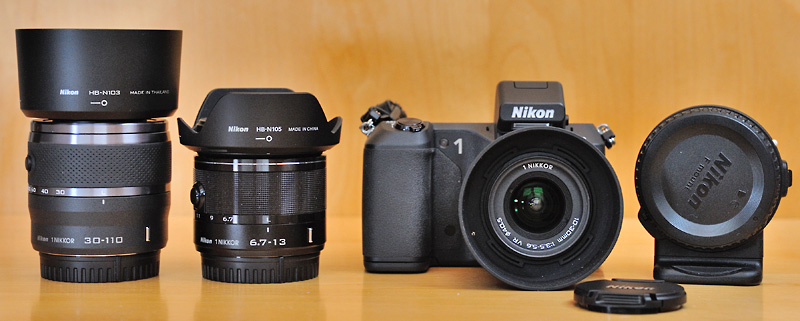
|
|
I am currently trying these parts of the System 1: the 1 V2 with the 10-30mm f/3.5-5.6 VR kit lens. On the left the 30-110mm f/3.8-5.6 VR telephoto zoom and the 6.7-13mm f/3.5-5.6 VR super wide-angle zoom. The FT-1 adapter on the right allows the usage of F-Mount lenses. |
First of all and not surprising: This system is really small and lightweight. With a Nikon 1 camera you are inconspicuous. In a crowd of P&S shooters you won't attract attention. The equipment shown above covers FX equivalent focal lengths from 18mm to 300mm. Everything together (without the FT-1) weighs only about 800g! Due to the low weight and the fact that it can be remote-controlled by the cheap ML-L3, this is the camera to mount on a monopod for holding it over cliffs in order to get unusual views. Or upwards for having a close look into a bird's nest... A pity Nikon Camera Control Pro is not supported. Maybe an alternative: using your smartphone via the WU-1B WiFi adapter.
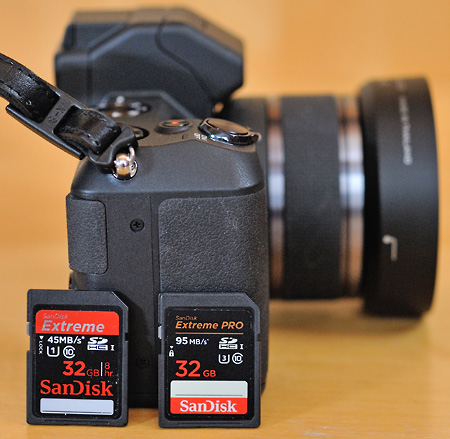
|
|
The Nikon 1 V2 is a fast camera. But it is not neccessary to buy expensive memory cards. I didn't measure a speed difference between SanDisk's Extreme and Extreme PRO cards when used in the V2.
|
Compared to an FX sensor the CX sensor is noisy. Again no surprise. But everything is relative: at ISO 400 the V2 produces much less noise than the Fujichrome Sensia ISO 100 slide film I used in earlier times. Seen absolutely: up to ISO 400 there is no problem with noise. ISO 800 is well usable. But I would try to avoid higher ISO values.
We DSLR shooters know: Nikon lets us pay for buffer capacity. The D4s ist super fast, the D810 is acceptable, the D7100 is terribly slow. Surprising: the buffer of the V2 can hold up to 40 RAW images. For continuous shooting you can select 5, 15, 30 or 60fps. The autofocus system is a hybrid of phase detection and contrast detection. It works accurately, fast and up to 15fps. In terms of speed, this camera is a real bargain!
Very good are the ergonomics, the display, the electronic viewfinder and the build quality. Two things are a bit disappointing: the flash system is not compatible to anything and the camera needs unique batteries and a special charger.
On the web you will find comments like this: "The Nikon 1 32mm f/1.2 is a real bargain! It gives you an 85mm f/1.2 FX equivalent for less than half the price of the AF-S Nikkor 85mm f/1.4!" Of course, that is baloney! I have not tried it yet, but after all I've read the 32mm f/1.2 seems to be a great lens. A typical reason to buy it - like for the AF-S Nikkor 85mm f/1.4 - is the wish to isolate the subject from the background. But in terms of depth of field, the 32mm f/1.2 has an FX equivalent of a 85mm f/3.3. That is just the crop factor of 2.7, equivalent to nearly 3 f-stops! Thus, the 85mm f/1.4 FX lens isolates your subject much better.
If you set your CX and FX cameras to ISO 400 and mount the 32mm f/1.2 or the 85mm f/1.4 respectively, the Nikon 1 lens ist faster. Assuming you use both lenses wide open then if you need a 1/125sec on FX, you just need a 1/180sec on CX. That's true but it is not the whole truth! The FX camera is much less noisy, so just set it to ISO 1600 or 3200, and the FX combo will be much faster (1/500 or 1/1000sec)!
"Because of the small sensor you get much more depth of field!" That is another typical assumption you will find about small image sensors. Yes, it is true: with a CX camera at 13mm (=35mm in FX) and F5.6 you will get much more DOF than with a FX camera at 35mm and F5.6. But again, it is not the whole truth: stop down the FX camera to F16 and you have identical DOF on both cameras. But if you stop down the CX camera to F16 you will get a huge depth of field, unreachable for an FX camera. That is correct, but the results will appear a bit fuzzy all over because of diffraction! The theoretical diffraction limit of the V2 is at about F5.3. Therefore you should not stop down further than F5.6 or F8 usually.
Another problem is the size of the autofocus sensor. The smaller the image sensor the larger is the autofocus sensor in relation to the image. In many situations that makes focussing less precise. Capture NX2 allows to display the focus sensor, the screenshots below show the difference.
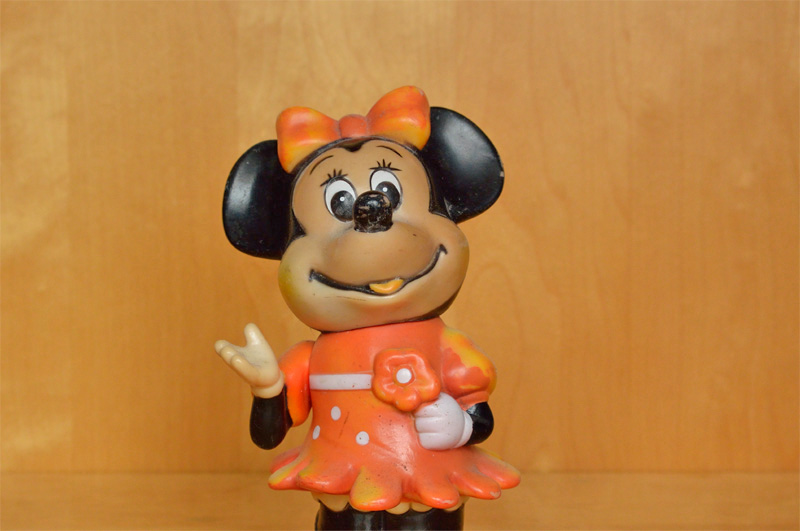
|
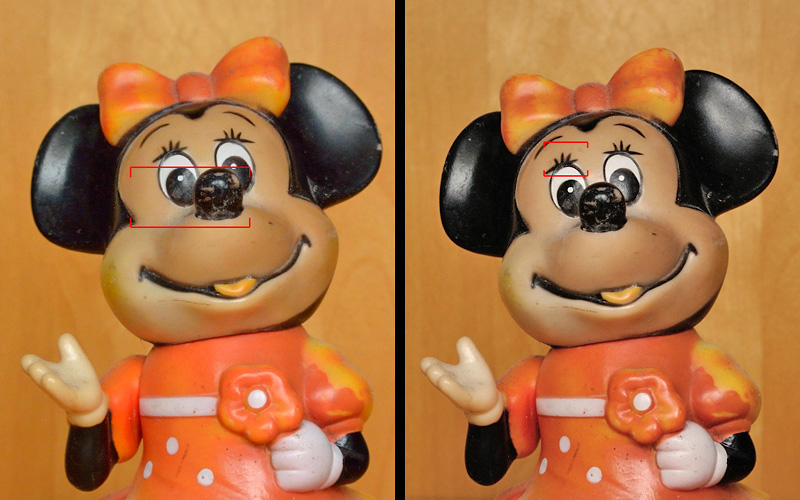
|
|
I made two identical shots of Minnie Mouse, one with the V2 at 22mm and one with the D700 at 60mm. The two crops show the size of the AF sensors. Left the CX camera, right the FX one. |
The most important advantage in my eyes is the size: the smaller sensor leads to much smaller and more lightweight equipment. I have already mentioned that above.
Secondly the small sensor is usable for microphotography. For example: the AF-S Micro-Nikkor 60mm f/2.8 hat a maximum magnification of 1:1. On a FX camera a magnification of 1:1 means you can photograph a square of 36x24mm. The lens also performs very good on the V2. But 1:1 here means you can photograph a square of 13.2x8.8mm! For photographing such small subjects with an FX camera you would need a magnification of 2.7:1, which in turn means you have to buy special equipment. I'm planning to make closer tests with the V2 for this sort of photography soon.
My three zoom lenses are sharp and contrasty lenses. But you have to be careful when shooting into the sun! The build quality is fine. Every current Nikkor 1 lens has a bayonet mount made of metal.
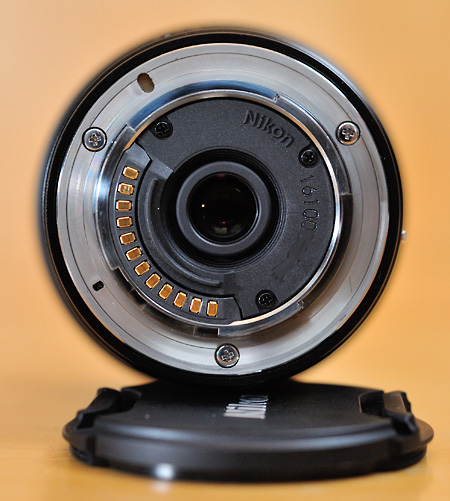
|
|
The lens' mount has no mechanical coupling elements and the diaphragm is completely closed.
|
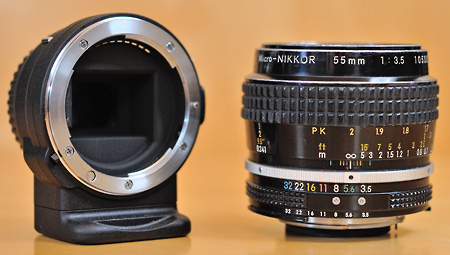
|
|
My good old Micro-Nikkor 55mm f/3.5 is not mountable!
|
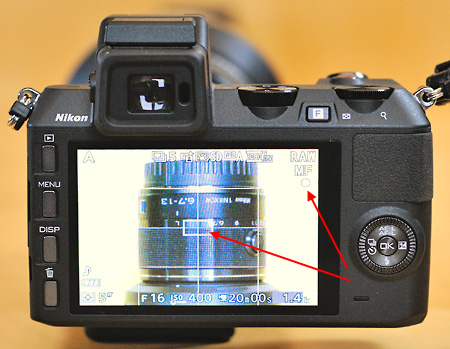
|
|
With a CPU lens on the FT1 you have a focus indicator on the fixed central focus sensor.
|
Nikon also offers a counterpart of their 18-200mm DX or 28-300mm FX superzooms respectively: the 10-100mm f/4-5.6 VR.
The most expensive lens of the system ist the super-telephoto zoom 70-300mm f/4.5-5.6 VR. It currently costs around 900 euros in Germany. This lens has a very good reputation.
In contrast to the zooms Nikon has only a poor lineup of primes in their System 1: a 10mm f/2.8 wide-angle lens, a 18.5mm f/1.8 standard lens and the above-mentioned short telephoto lens 32mm f/1.2. The 18.5 and 32mm lenses have a very good reputation, while the 10mm seems to be not much better than the kit-lens at 10mm. On the other hand the 10mm is a small pancake lens. The primes don't offer VR. I miss two lenses here: a fast (f/1.2) wide-angle and a Micro-Nikkor.
BTW: perhaps some Nikkor 1 lenses - especially the 10mm and 18.5mm primes - could be suitable - in reversed position - for microphotography applications. But there is a practical problem, the aperture of a One lens is completely closed if the lens is dismounted. A tube with some electronics in it would be necessary here, but I guess Nikon is not planning to produce something like that.
Thanks to the FT1 adapter you can use a lot of old Nikkor glass, even non-AI lenses. But be careful! Not every lens is mountable. Inside the adapter there is not enough space for some lenses!
If a non-CPU lens is mounted the camera does not show a focus indicator. Thus you must focus visually on the screen or in the EVF. If necessary, you can zoom in.
Non-CPU lenses allow A and M exposure mode. Matrix metering is not available.
With a CPU lens all exposure options are usable. You must focus manually, but now the camera additionally offers you a focus indicator coupled to the central focus sensor.
If the AF-S lens is set to M it behaves like a CPU lens described above. Up to this point everything sounds fine.
In AF-mode you have unpleasant restrictions compared to native Nikon 1 lenses:
The performance of F-Mount Nikkors on the V2 is a mixed bag. The cheap AF-S 50mm f/1.8 delivers very good image quality. In contrast, my AF-S Micro-Nikkor 105mm f/2.8 doesn't produce consistent results, sometimes the quality is fine, sometimes the lens produces a more than usual amount of bokeh fringing. Moreover the AF of the V2 doesn't like the 105mm VR. For more details have a look at my subjective lens evaluations.
Back to my AF-S 300mm: the image quality delivered in conjunction with the Nikon 1 V2 is fine and the AF restrictions are okay for stationary subjects and if the unit is mounted on a tripod. But if a slightly shaking photographer photographs moving animals hand-held with such a setup, the quality of the results is a game of luck! The relatively large AF-sensor described above is another practical problem for me. At last: the weight distribution of the combo V2 + FT1 + 300mm is not exactly optimal.
What are the alternatives? For example using a Nikkor 1 70-300mm zoom on my V2. It delivers the same 810mm FX equivalent, no restrictions in the AF-system, due to the weight of 550g probably good to hold. But it is an expensive lens!
A second alternative is mounting a TC-20EIII between my D4 and 300mm lens which would result in a 600mm f/8. Restriction: only 11 of 51 AF sensors are usable with an f/8 lens. For equalling the 810mm I would have to take a 8.9MP-crop from middle of the image. About the possible image quality of this converter in conjunction with the 300mm f/4 there I found contradictory reviews on the Web.
I am currently not sure what to do, but I will let you know...
At last a word about the combo TC-14EII + 300mm AF-S on the V2: yes it works and despite diffraction image quality is still very good, if you stop only slightly down. Not really surprising: the focus hunts a lot and the handling hand-held gets even more problematical.
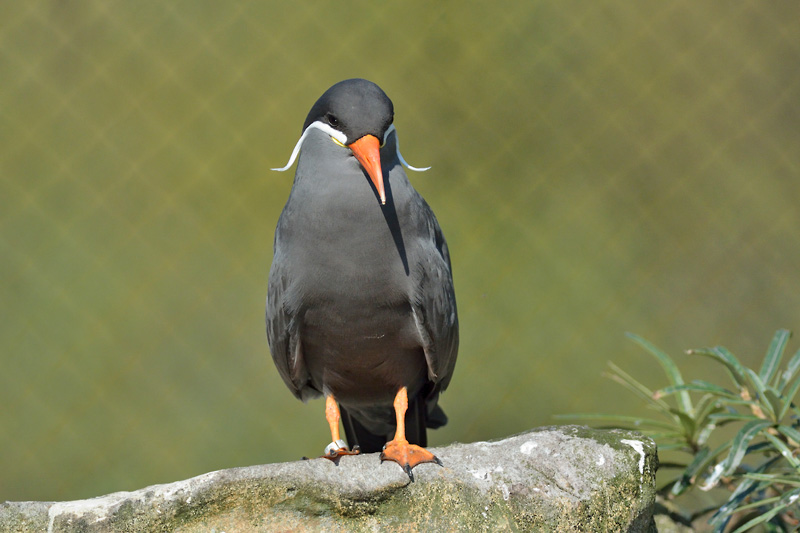
|
|
Visit in our local zoo: Inca tern. V2+FT1+AF-S 300mm at ISO 400, F5 and 1/1250, hand-held. |
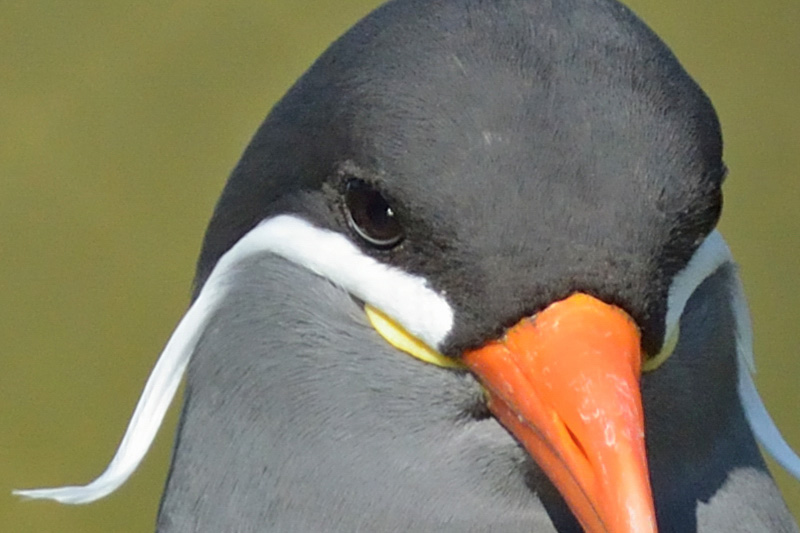
|
|
100%-crop of the above image. |

|
|
Visit in our local zoo: a distant relative of mine. V2+FT1+AF-S 300mm at ISO 800, F4 and 1/250, rested on the fence. |
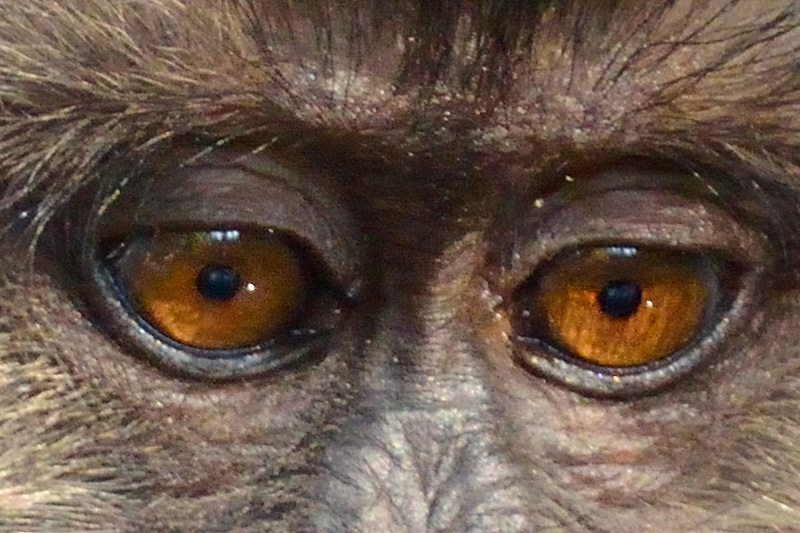
|
|
100%-crop of the above image. |
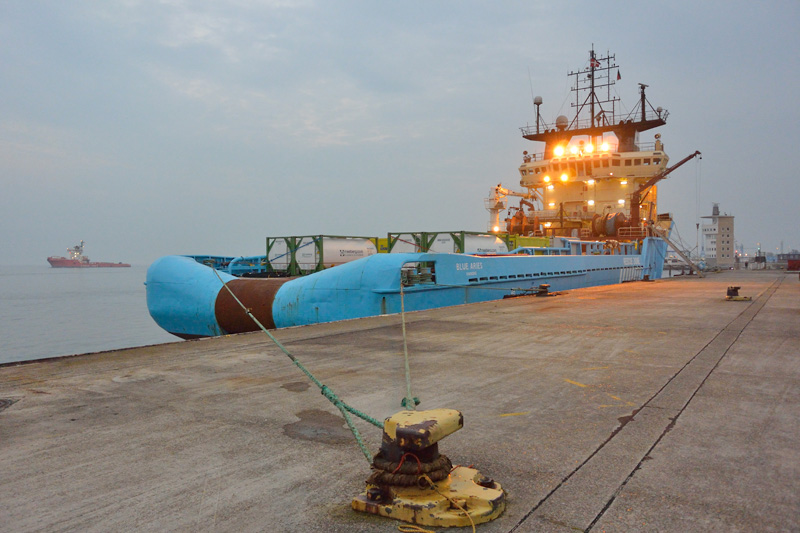
|
|
Evening in Cuxhaven, at the mouth of river Elbe. V2 + 10-30mm kit lens at 10mm, ISO 640, F3.5 and 1/60. |
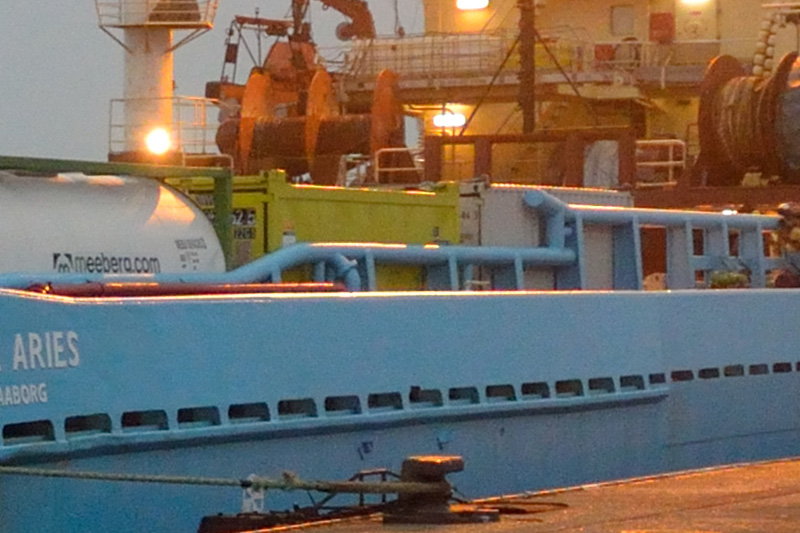
|
|
100%-crop of the above image. |
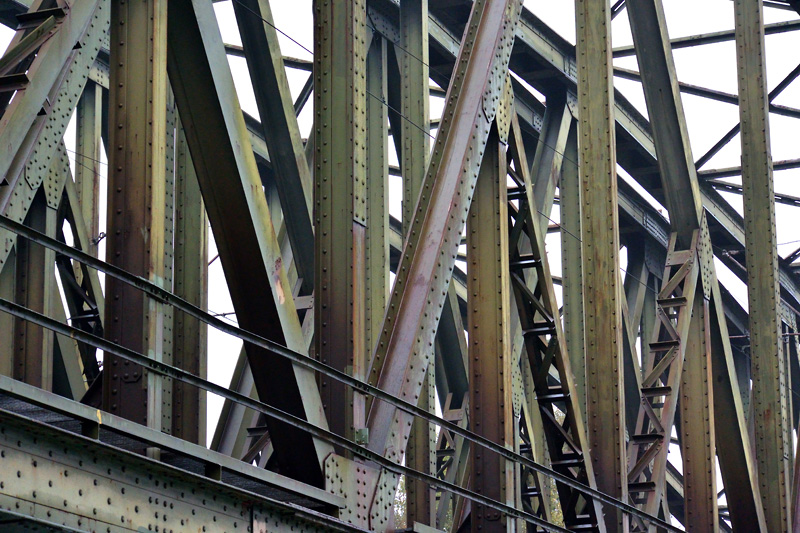
|
|
Railway bridge across the Dortmund-Ems Canal. V2 + 30-110mm at 41mm, ISO 800 and F4. |
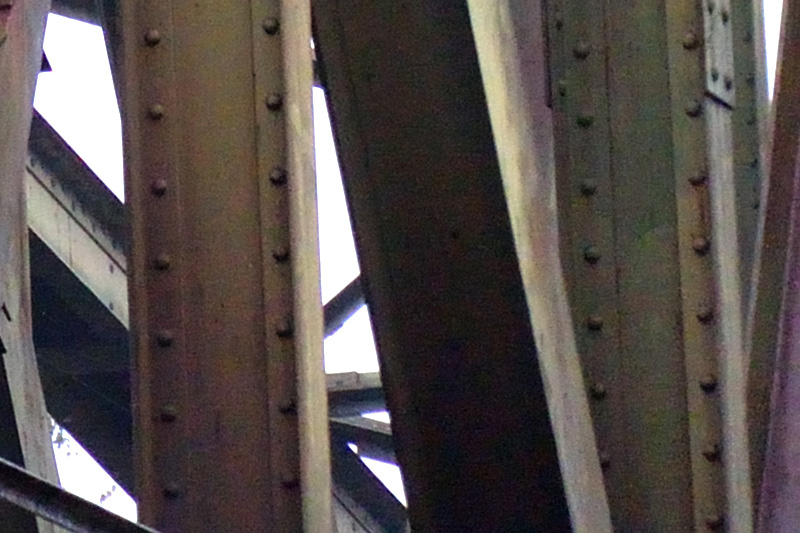
|
|
100%-crop of the lower right corner of the above image. |
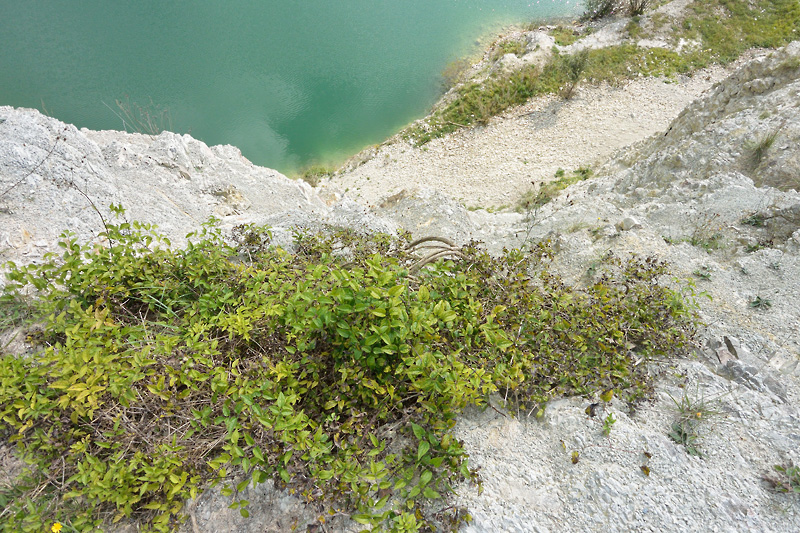
|
|
Above the edge - in a former limestone mine in Rheine. V2 + 6,7-13mm at 6,7mm, ISO 160 and F5, mounted on a momopod for holding over the edge. |